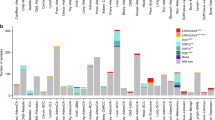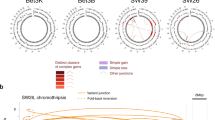Abstract
Chromosomal aberrations are common in cancers. However, the search for chromosomal aberrations leading to development of specific solid tumors has been severely hindered because the majority of solid tumors have complex chromosomal aberrations that differ within the same tumor types. A similar phenomenon exists in immortalized cell lines. The underlying mechanisms driving these diverse aberrations are largely unknown. Telomeres play crucial roles in protecting the integrity of eucaryotic chromosomes and maintaining genomic stability of human cells. Telomere lengths on individual chromosomes in normal human somatic cells are heterogeneous and undergo progressive shortening with aging process. In this study, for the first time, a molecular cytogenetic method using sequential telomere quantitative fluorescence in situ hybridization and spectral karyotyping on the same human metaphases was applied successfully to examine the dynamic profiles of individual telomere shortening and their relationship to chromosome aberrations in multiple human cell lines undergoing immortalization. Human ovarian surface epithelial cells and esophageal epithelial cells were immortalized by the expression of HPV16 E6 and E7, which drive cells to proliferate by inactivating p53 and Rb genes. In these cell lines, we consistently detected large-scale differences in telomere signal intensities not only among nonhomologous chromosome arms but also between some homologous chromosome arms. The cell lines derived from different donors had different profiles of critically short telomeres (lacking telomere signals). Strikingly, the different profiles of chromosomal structural aberrations in multiple immortalized cell lines were highly significantly associated with the distinct distributions of critically short telomeres in whole-genome. Since cellular immortalization is one of the hallmarks of cancer, our findings suggest that distinct profiles of critically short telomeres in different human individuals might play an essential role in determining the complex and individual-specific chromosomal structural aberrations in human solid tumors.
This is a preview of subscription content, access via your institution
Access options
Subscribe to this journal
Receive 50 print issues and online access
$259.00 per year
only $5.18 per issue
Buy this article
- Purchase on Springer Link
- Instant access to full article PDF
Prices may be subject to local taxes which are calculated during checkout







Similar content being viewed by others
References
Artandi SE, Chang S, Lee SL, Alson S, Gottlieb GJ, Chin L and DePinho RA . (2000). Nature, 406, 641–645.
Baird DM, Rowson J, Wynford-Thomas D and Kipling D . (2003). Nat. Genet., 33, 203–207.
Benn PA . (1976). Am. J. Hum. Genet., 28, 465–473.
Blackburn EH . (2001). Cell, 106, 661–673.
Davidson JM, Gorringe KL, Chin SF, Orsetti B, Besret C, Courtay-Cahen C, Roberts I, Theillet C, Caldas C and Edwards PA . (2000). Br. J. Cancer, 83, 1309–1317.
de Lange T . (1995). Telomeres. Blackburn EH, Greider CW (eds). Cold Spring Harbor Laboratory Press: NY, pp. 265–293.
de Lange T . (2002). Oncogene, 21, 532–540.
Deng W, Tsao SW, Guan XY, Lucas JN and Cheung AL . (2003a). Genes Chromosomes Cancer, 37, 92–97.
Deng W, Tsao SW, Lucas JN, Leung CS and Cheung AL . (2003b). Cytometry, 51A, 46–51.
der-Sarkissian H, Bacchetti S, Cazes L and Londono-Vallejo JA . (2004). Oncogene, 23, 1221–1228.
Drexler HG, Dirks WG and MacLeod RA . (1999). Leukemia, 13, 1601–1607.
Ducray C, Pommier JP, Martins L, Boussin FD and Sabatier L . (1999). Oncogene, 18, 4211–4223.
Duensing S, Lee LY, Duensing A, Basile J, Piboonniyom S, Gonzalez S, Crum CP and Munger K . (2000). Proc. Natl. Acad. Sci. USA, 97, 10002–10007.
Dunham MA, Neumann AA, Fasching CL and Reddel RR . (2000). Nat. Genet., 26, 447–450.
Gisselsson D, Jonson T, Petersen A, Strombeck B, Dal Cin P, Hoglund M, Mitelman F, Mertens F and Mandahl N . (2001). Proc. Natl. Acad. Sci. USA, 98, 12683–12688.
Goytisolo FA, Samper E, Edmonson S, Taccioli GE and Blasco MA . (2001). Mol. Cell. Biol., 21, 3642–3651.
Graakjaer J, Bischoff C, Korsholm L, Holstebroe S, Vach W, Bohr VA, Christensen K and Kolvraa S . (2003). Mech. Ageing Dev., 124, 629–640.
Graakjaer J, Pascoe L, Der-Sarkissian H, Thomas G, Kolvraa S, Christensen K and Londono-Vallejo JA . (2004). Aging Cell, 3, 97–102.
Griffith JD, Comeau L, Rosenfield S, Stansel RM, Bianchi A, Moss H and de Lange T . (1999). Cell, 97, 503–514.
Hanahan D and Weinberg RA . (2000). Cell, 100, 57–70.
Harley CB, Futcher AB and Greider CW . (1990). Nature, 345, 458–460.
Harris CP, Lu XY, Narayan G, Singh B, Murty VV and Rao PH . (2003). Genes Chromosomes Cancer, 36, 233–241.
Hastie ND, Dempster M, Dunlop MG, Thompson AM, Green DK and Allshire RC . (1990). Nature, 346, 866–868.
Hemann MT, Strong MA, Hao LY and Greider CW . (2001). Cell, 107, 67–77.
Henson JD, Neumann AA, Yeager TR and Reddel RR . (2002). Oncogene, 21, 598–610.
Hsu HL, Gilley D, Galande SA, Hande MP, Allen B, Kim SH, Li GC, Campisi J, Kohwi-Shigematsu T and Chen DJ . (2000). Genes Dev., 14, 2807–2812.
ISCN (1995). An International System for Human Cytogenetic Nomenclature. Mitelman F (ed). S Karger: Basel.
Karlseder J . (2003). Cancer Lett., 194, 189–197.
Kawai K, Viars C, Arden K, Tarin D, Urquidi V and Goodison S . (2002). Genes Chromosomes Cancer, 34, 1–8.
Keys B, Serra V, Saretzki G and Von Zglinicki T . (2004). Aging Cell, 3, 103–109.
Lansdorp PM, Verwoerd NP, van de Rijke FM, Dragowska V, Little MT, Dirks RW, Raap AK and Tanke HJ . (1996). Hum. Mol. Genet., 5, 685–691.
Li GZ, Eller MS, Firoozabadi R and Gilchrest BA . (2003). Proc. Natl. Acad. Sci. USA, 100, 527–531.
Londono-Vallejo JA, DerSarkissian H, Cazes L and Thomas G . (2001). Nucleic Acids Res., 29, 3164–3171.
Martens UM, Zijlmans JM, Poon SS, Dragowska W, Yui J, Chavez EA, Ward RK and Lansdorp PM . (1998). Nat. Genet., 18, 76–80.
Masters J . (2002). Int. J. Cancer, 99, 154.
Masutomi K, Yu EY, Khurts S, Ben-Porath I, Currier JL, Metz GB, Brooks MW, Kaneko S, Murakami S, DeCaprio JA, Weinberg RA, Stewart SA and Hahn WC . (2003). Cell, 114, 241–253.
McEachern MJ, Krauskopf A and Blackburn EH . (2000). Annu. Rev. Genet., 34, 331–358.
Mitelman F, Mertens F and Johansson B . (1997). Nat. Genet. vol. Spec issue, 417–474.
Munger K and Howley PM . (2002). Virus Res., 89, 213–228.
Poon SSS, Martens UM, Ward RK and Lansdorp PM . (1999). Cytometry, 36, 267–278.
Samper E, Goytisolo FA, Slijepcevic P, van Buul PP and Blasco MA . (2000). EMBO Rep., 1, 244–252.
Sherr CJ and McCormick F . (2002). Cancer Cell, 2, 103–112.
Smogorzewska A, Karlseder J, Holtgreve-Grez H, Jauch A and de Lange T . (2002). Curr. Biol., 12, 1635–1644.
Stewart SA, Ben-Porath I, Carey VJ, O'Connor BF, Hahn WC and Weinberg RA . (2003). Nat Genet., 33, 492–496.
Tsao SW, Mok SC, Fey EG, Fletcher JA, Wan TS, Chew EC, Muto MG, Knapp RC and Berkowitz RS . (1995). Exp. Cell Res., 218, 499–507.
Tsao SW, Wong N, Wang X, Liu Y, Wan TS, Fung LF, Lancaster WD, Gregoire L and Wong YC . (2001). Cancer Genet. Cytogenet., 130, 141–149.
van Bokhoven A, Caires A, Maria MD, Schulte AP, Lucia MS, Nordeen SK, Miller GJ and Varella-Garcia M . (2003). Prostate, 57, 226–244.
van Steensel B, Smogorzewska A and de Lange T . (1998). Cell, 92, 401–413.
Wright WE and Shay JW . (1992). Exp. Gentol., 27, 383–389.
Wright WE and Shay JW . (2002). Nat. Biotechnol., 20, 682–688.
Zhang H, Tsao SW, Jin C, Strombeck B, Yuen PW, Kwong YL and Jin Y . (2004). Cancer Genet. Cytogenet., 150, 144–152.
Zijlmans JM, Martens UM, Poon SS, Raap AK, Tanke HJ, Ward RK and Lansdorp PM . (1997). Proc. Natl. Acad. Sci. USA, 94, 7423–7428.
Acknowledgements
We thank Drs PM Lansdorp and SSS Poon (BC Cancer Research Center, Canada) for the Q-FISH software (TFL-TELO); the Department of Pediatrics & Adolescent Medicine, University of Hong Kong, for use of SKY facilities; J Cheung, A Li, T Chan and B Lau for technical assistance. This study was supported by a grant from the Research Grants Council of Hong Kong Special Administrative Region, China (Project No. HKU 7385/03M) and a research grant from the University of Hong Kong CRCG (No. 10204355/07419/20200/323/01).
Author information
Authors and Affiliations
Corresponding author
Rights and permissions
About this article
Cite this article
Deng, W., Tsao, S., Guan, XY. et al. Distinct profiles of critically short telomeres are a key determinant of different chromosome aberrations in immortalized human cells: whole-genome evidence from multiple cell lines. Oncogene 23, 9090–9101 (2004). https://doi.org/10.1038/sj.onc.1208119
Received:
Revised:
Accepted:
Published:
Issue Date:
DOI: https://doi.org/10.1038/sj.onc.1208119
Keywords
This article is cited by
-
Identification of miR-515-3p and its targets, vimentin and MMP3, as a key regulatory mechanism in esophageal cancer metastasis: functional and clinical significance
Signal Transduction and Targeted Therapy (2020)
-
Targeting TRIM3 deletion-induced tumor-associated lymphangiogenesis prohibits lymphatic metastasis in esophageal squamous cell carcinoma
Oncogene (2019)
-
β-catenin downregulates Dicer to promote ovarian cancer metastasis
Oncogene (2017)
-
Combining carbon ion irradiation and non-homologous end-joining repair inhibitor NU7026 efficiently kills cancer cells
Radiation Oncology (2015)
-
SAA1 polymorphisms are associated with variation in antiangiogenic and tumor-suppressive activities in nasopharyngeal carcinoma
Oncogene (2015)



